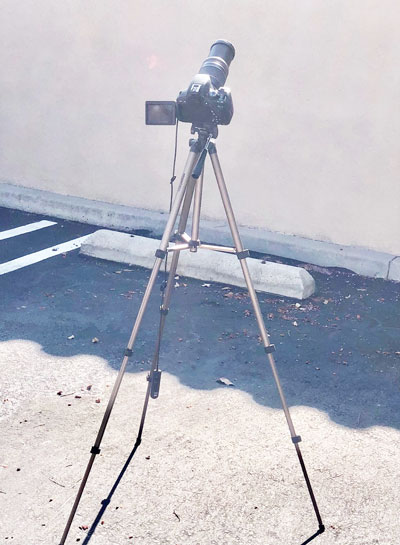Greetings from Palmia Observatory
Well this week we were excited by the success of OCA Craig Bobchin in capturing a solar transit of the ISS.
Here is Craig's composite image of several frames taken with a Coronado Solarmax 90 telescope and attached video camera. He was lucky enough that he could position his observing setup right at the transit centerline and take some images. As I recall, Craig is somewhere in Texas now, anyway great job and thanks for sharing, Craig!
 |
| Stacked group of video frames of ISS Solar Transit (Source: OCA Craig Bobchin) |
Well, I thought I should try to do the same type of thing whenever the next ISS solar transit occurred that was near here so we would not have to travel. It turns out that just after Craig shared his image, another OCA Jonathan Hankey, after sharing some of his solar prominence images, mentioned that the next ISS solar transit in the OC area was predicted for Sunday, August 15. Hey, let's see if we can get setup and capture the solar transit. Thanks for alerting us, Jonathan!
The details of when and where to view the transit can be found on many online tools and websites. Here is on prediction provided at https://transit-finder.com
Wow, so this transit is only going to be visible here for 0.78 seconds! This capture time is so short that we are going to have to switch to video recording.
 |
| ISS Transit prediction for Irvine area for August 15 (Source: https://transit-finder.com) |
Ok, the image of the ISS on the sun is pretty small, something like 29 arc-seconds, which is just about the same as 1/120 of the image of the solar disk. For this first attempt, I elected to just use a DSLR with 300mm telephoto lens and filter and select the video format rather than individual photos. The ISS will show up as just a dozen pixels or so, but using the DLSR was easy to set up for this first attempt at capturing an ISS Solar Transit. In the future, if this first attempt works out, we might want to go with longer focal length to get more detail
 |
| DSLR with 300mm lens and filter on flimsy tripod (Source: Palmia Observatory) |
So, after just walking outside at about 15 minutes before the predicted transit was enough time to setup the tripod and try to focus the camera. Then at about 3:39 PM and 50 seconds, I switched to video mode and collected about 20 seconds of DSLR movie frames. Were we going to be prepared enough and lucky enough to capture the transit?
Hooray, yes, the transit was indeed just barely visible in the movie. The prediction timing seemed to be right on. Here is one movie frame that shows the ISS entering from the lower right and appears just about bottom center in the image. So, we can see that the resolution is not very good, but at least it is there. I was worried that the highest available video capturing capability for that camera was just 1920 x 1080 pixels, which is about half the resolution possible in a camera RAW image, might be too low, but we can see at least a blurry black spot can be seen.
 |
| One 300mm DSLR movie frame with ISS entering at bottom center (Source: Palmia Observatory) |
The reality of capturing the transit is best seen in the movie video format. This video movie is about 8 seconds long and the transit starts just about 1/2 way through. You can spot the ISS entering from the bottom right of the image and exiting the frame at about center left. The online version of the video is best viewed in full screen mode because the transit happens very quickly and the contrast is quite dim. The online version seems to have less resolution too. More future lessons to be learned here too.
So, that was a pretty neat experience and hopefully other amateurs tried to capture the transit with longer focal length cameras and can let us in on the details. One lesson learned from this end was that when the camera is set to video mode, you can't use manual shutter timing option and have to use some other function like the built in shutter timing. So, there are a lot of details to be learned about how to transition from taking single DSLR astrophotos, to taking DSLR videos.
But, that is enough discussion of this first attempt at capturing an ISS solar transit for now because we need to pack our bags to travel to El Paso, TX as part of our road trip to visit two rocket launch sites. One is the Spaceport in New Mexico, where Richard Branson blasted into space with his rocket plane, and the other is down in Van Horn, TX, to see where Jeff Bezos blasted into space with his Blue Origin rocket. We don't think we can get an actual tour of the facilities and maybe just have to peer through the security fence, but at least we will try. By the way we are used to just peering through the fence, just like we do when we drive along the road in Boca Chica, TX to see what Elon Musk and SpaceX are doing at the Starship launch site. We will let you know what we find in the next blog post.
Until next time,

Congratulations. Good capture. I made my still from this video. https://youtu.be/DqYXZ5SuQ4g If you run it at .25 speed you'll see it go across. At normal speed it's almost invisible it goes by so fast.
ReplyDeleteHere's a colorized version of the image:
https://i.imgur.com/fdF0Tl7.jpeg